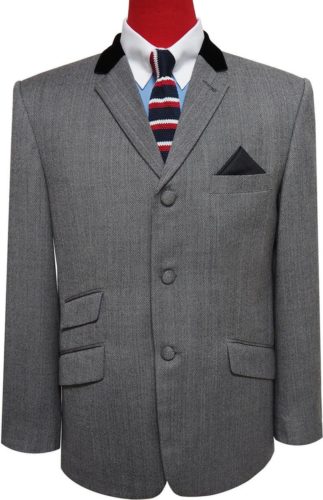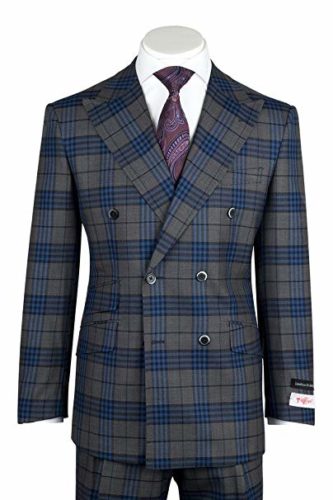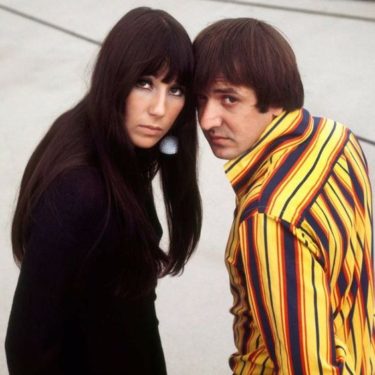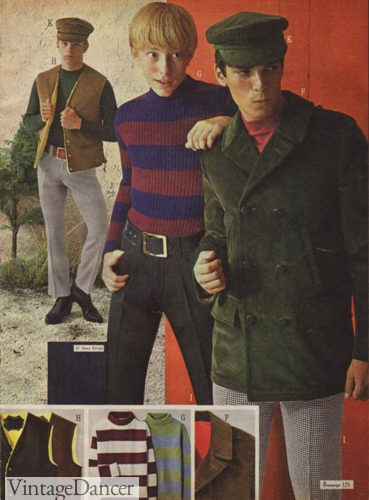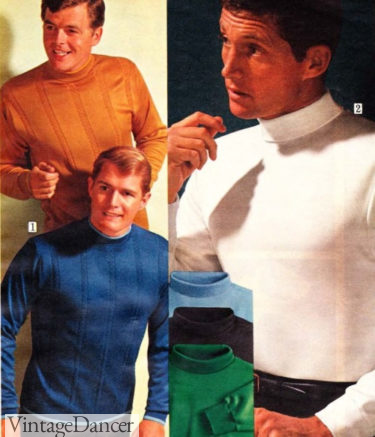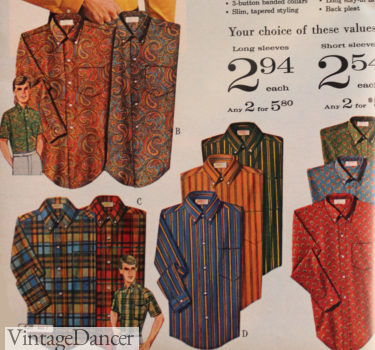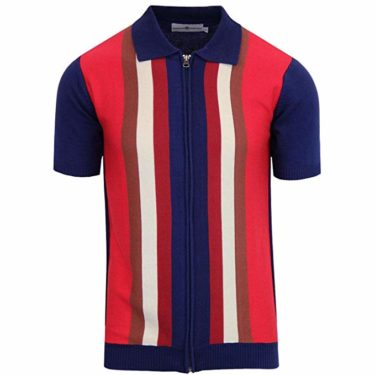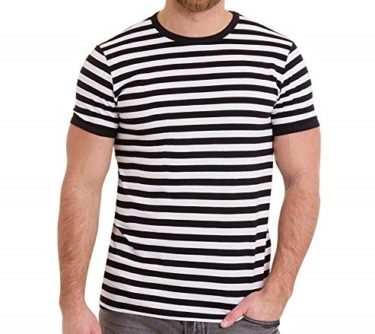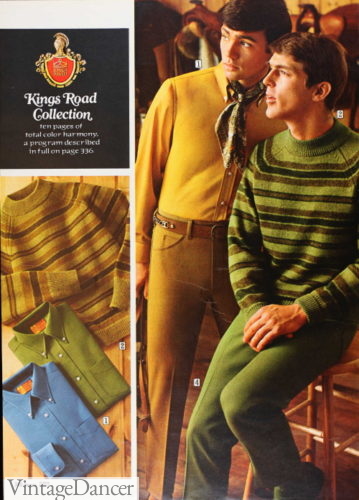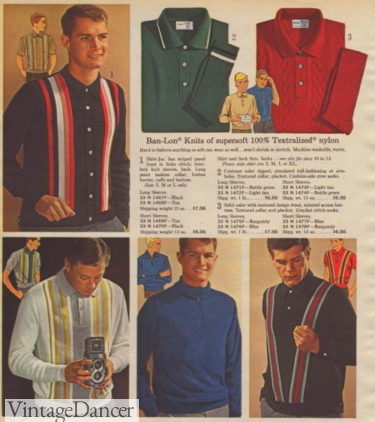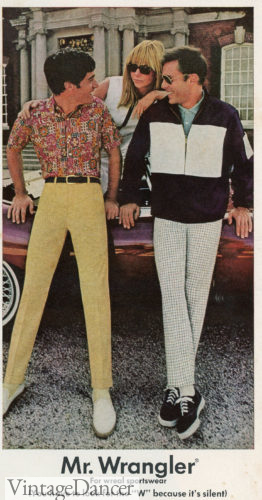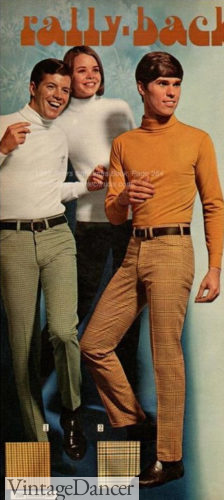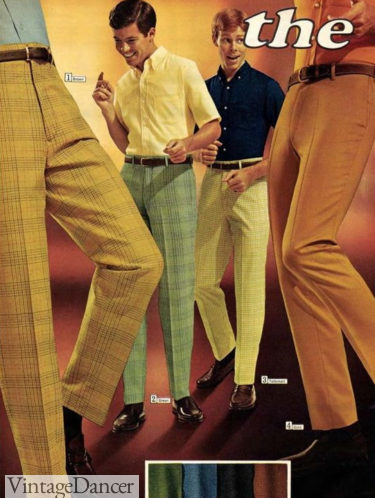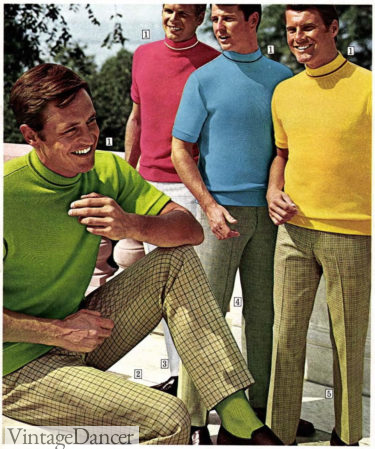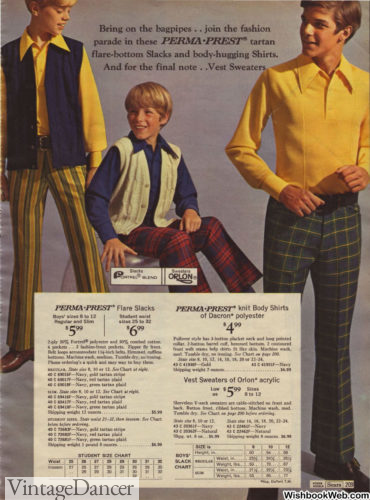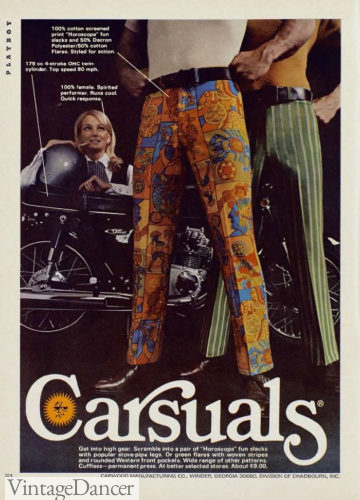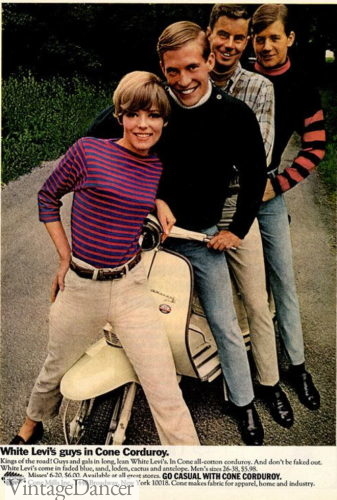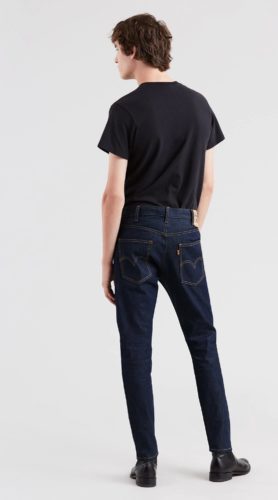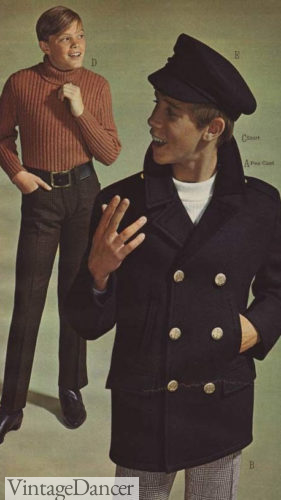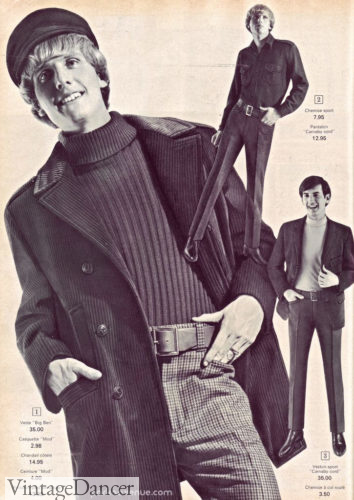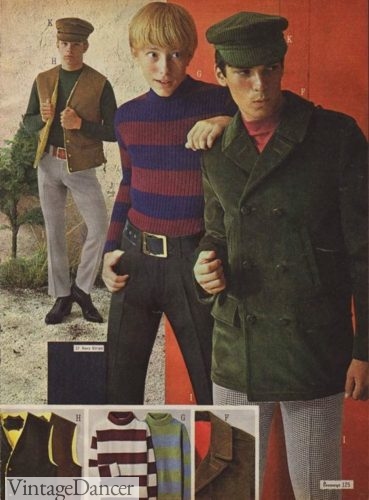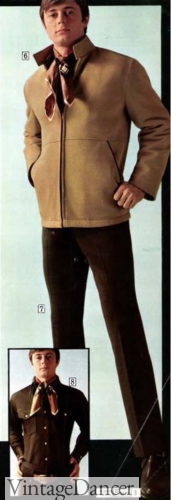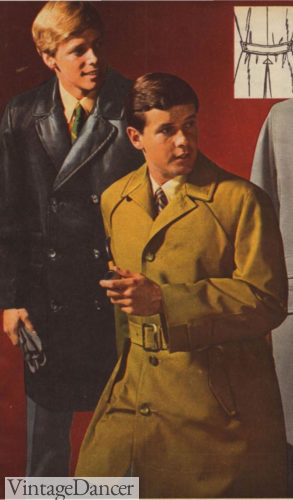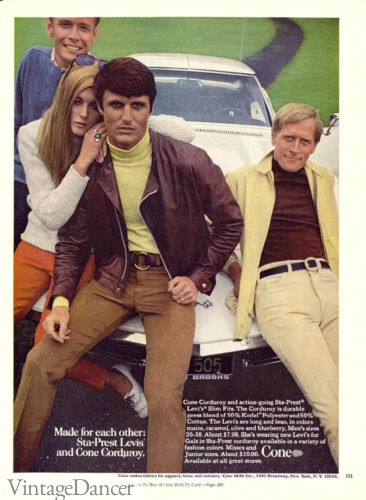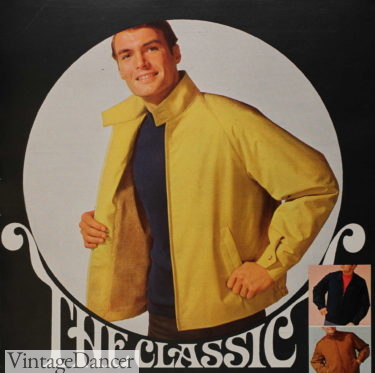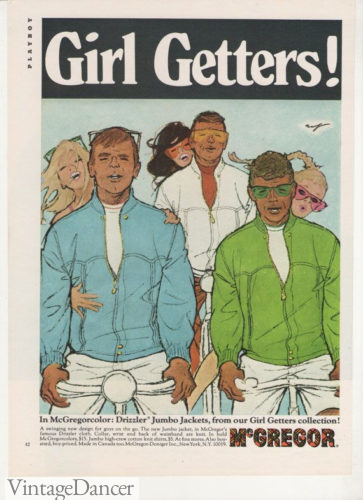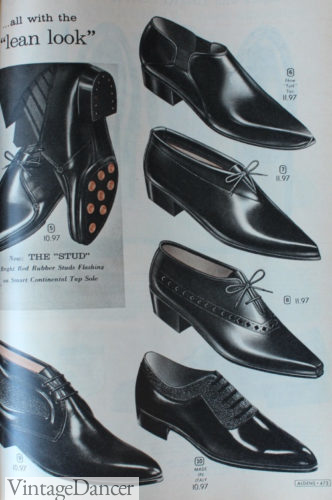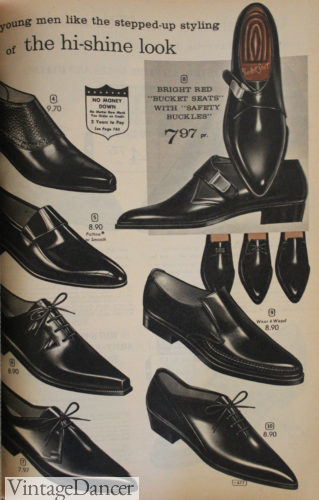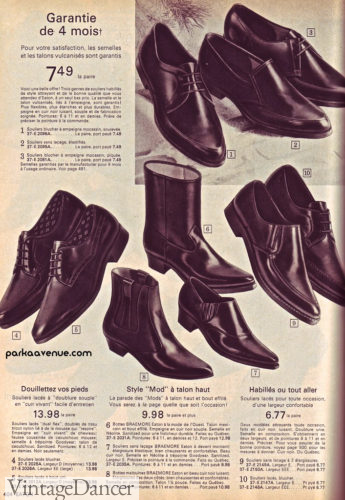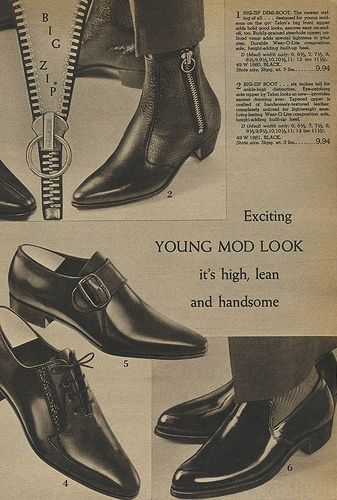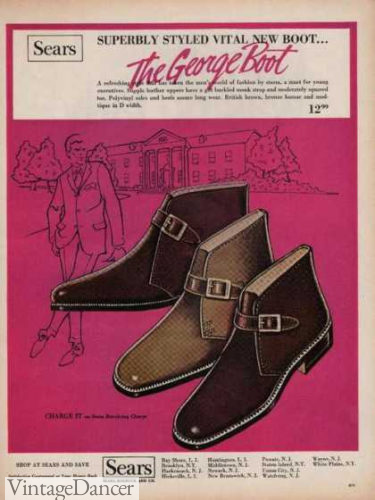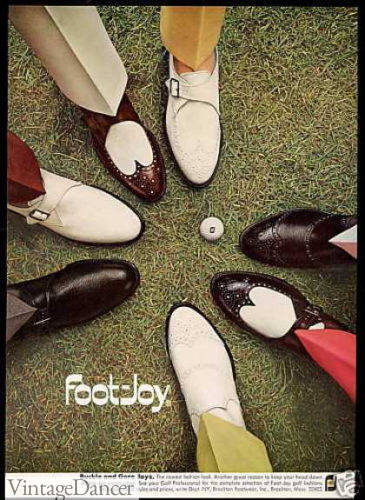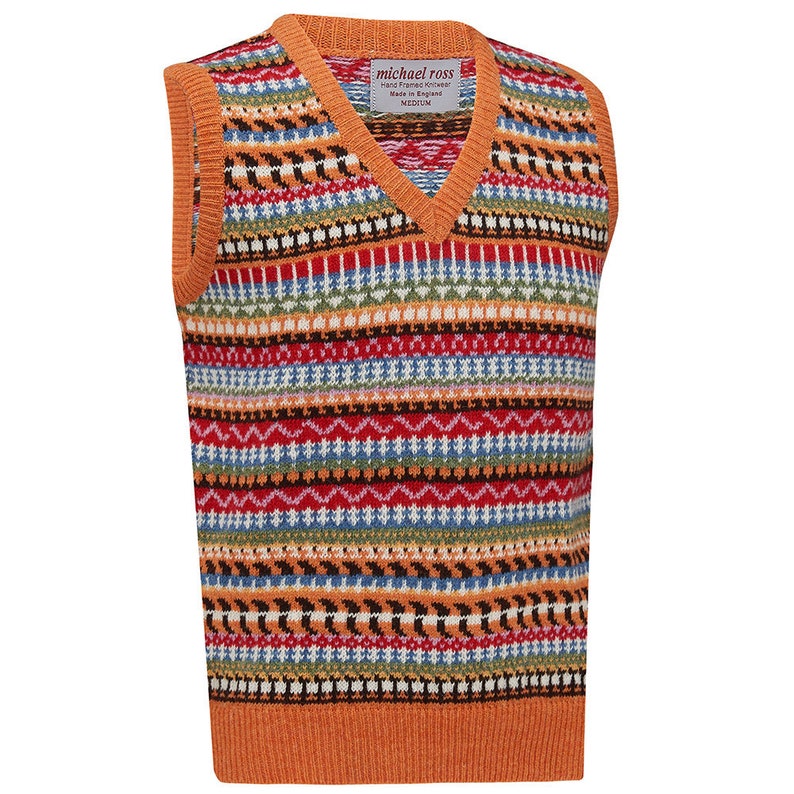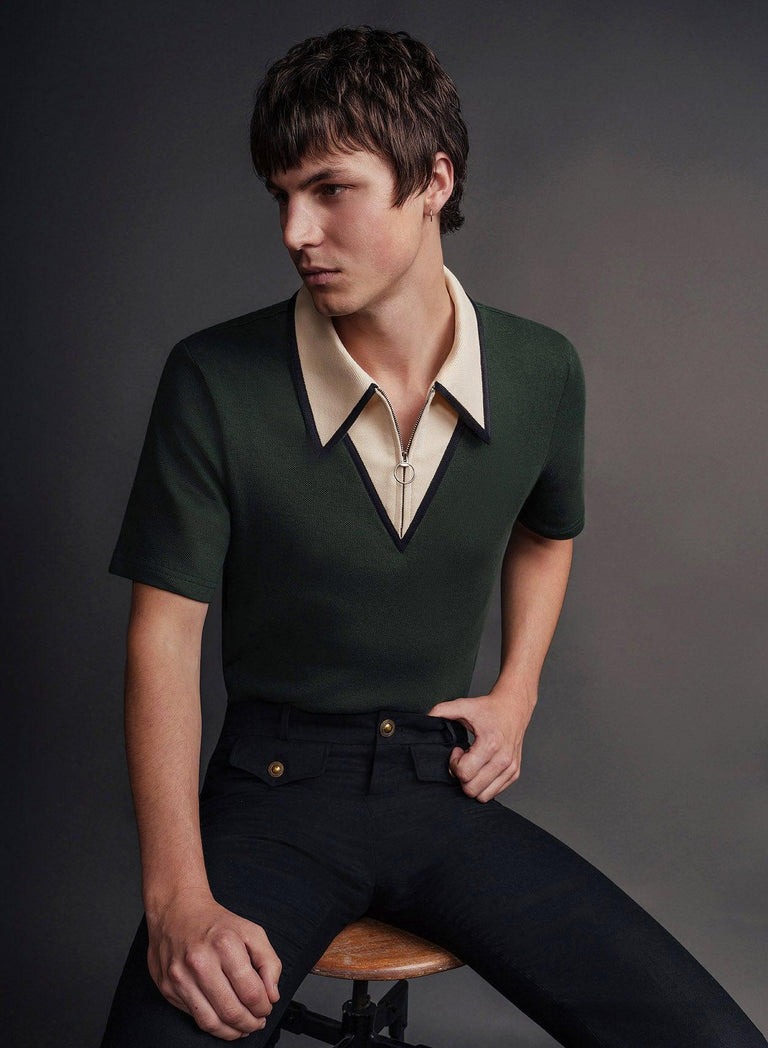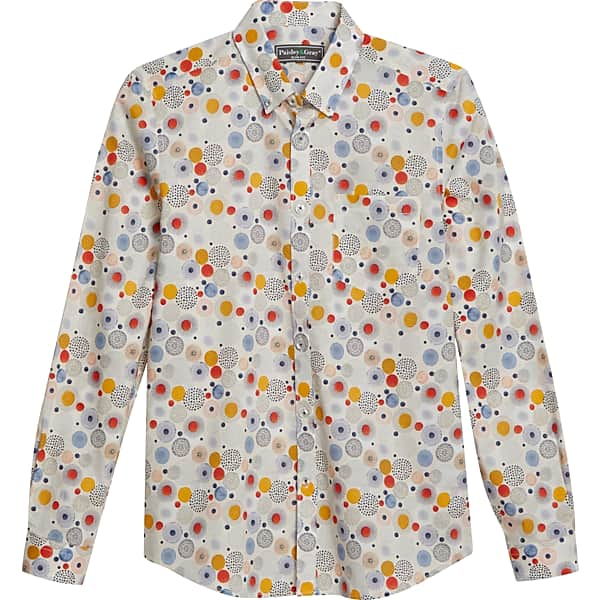The men’s mod look was first introduced to American youth in 1964 from British pop bands such as The Beatles who appeared on TV. They wore narrow lapel 4 button jackets, slim pants, and Cuban heeled boots on the Ed Sullivan show that year. The Rolling Stones also made an appearance wearing mod clothing with longer, shaggier hair.
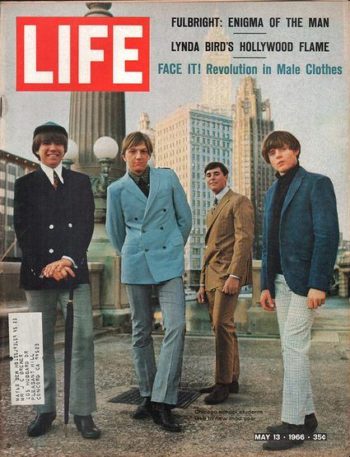
1966 Life magazine covered the trend of mod fashion
The 60s mod look mixed:
- Skinny rib body shirts, turtle necks, mod print sweaters in vibrant colors. Shop Shirts and sweaters.
- Dress shirts in bold stripes or big prints, white collars. Shop Shirts.
- Flag shirts, neckties, shoes, hats, pins.
- Skin-tight low waist denim/suede/poly knit pants with a small flare to fit over boots. Shop pants.
- Fitted blazers in rich fabrics (velvet, silk, damask), stripes, tweed and herringbone. Shop suits/sportcoats.
- Skinny ties or silk neckerchiefs in bright solid colors. Shop ties.
- Wide belts or hip chains.
- Large bead or hanging pendants necklaces.
- Chelsea boots, winklepickers, Shiny slip-ons. Shop shoes.
- Caps – fisherman style, cadet caps, newsboy caps. Shop hats.
The 60s Mods
Part throwback to the Edwardian age and part futuristic, Mod men’s clothing blended old and new together in a look that could be conservative yet trendy or outright flamboyant. The look dominated the UK but was less mainstream in the USA. Fashion-forward young men were the primary audience who looked to buy Mod clothing, thinking it would attract young girls who were obsessed with the British bands.
Mod clothing was made cheaply, lasting only a season, and replaced when new styles came in. For the first time, men joined the Fast Fashion race. Those not bold enough to fully embrace the Mod look found ample selection from mass-market department stores. The Nehru jacket, Apache scarf, Flower print shirts, bell-bottom pants, and tie-dyed and psychedelic printed T-shirts were common cross overs to the middle-class.
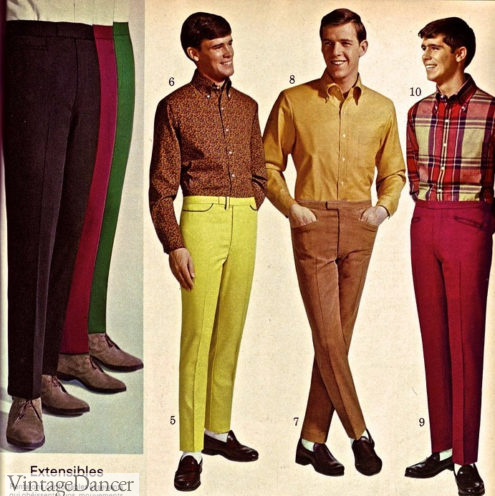
1966 mens mod drainpipe pants and button down shirts with loafers
Sharkskin suits (two-tone mohair with a shine), short double-breasted jackets (called bum freezers), long suit jackets, collarless jackets, and exaggerated collar jackets were all adopted by the mods. Some had velvet collars, most had narrow lapels and 3-4 high buttons. Double-breasted sport coats with deep side vents, wide lapels, and a short length, were sought after by most young mods. The blazers in stripes, solid blue with white buttons, olive green, and powder blue were just a few of the best colors/patterns. Some casual blazers had epaulets on the shoulders.
- Early 60s mod jacket
- Plaid Double Breasted Mod Suit
Instead of button-down shirts under their sport coats and blazers, mods wore a turtleneck or mock neck shirt. If a dress shirt was worn it had to be unique, perhaps white with an oversized spearpoint collar, stripes or a bold geometric, paisley, or psychedelic pattern. Neckties were optional, but usually black skinny knits or polka dot silks.
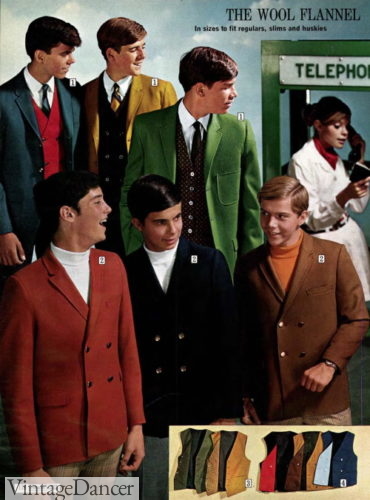
1969 mod men’s colorful suits
Motown bands such as The Temptations embraced the mod style with bright color suits and shiny black or white shoes. Most suits were specially designed for the group, often leading the trends mainstream would follow.
Learn more about 1960s men’s suits and sportscoats.
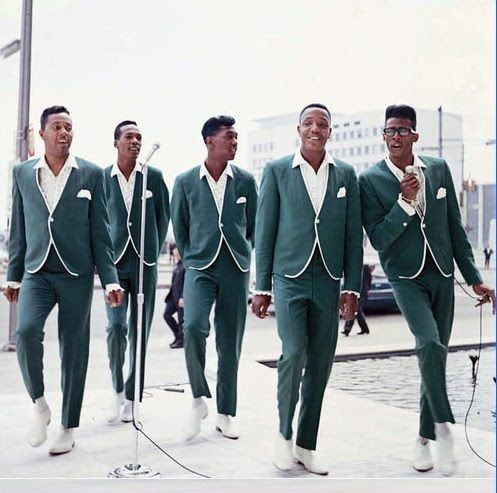
Temptations, green collarless suits with white piping and white boots
Mod Men’s Shirts
Take a look at men’s fashion options today and you may notice a strong resemblance to the ’60s. Slim fit knitted shirts, striped button downs, bold paisley prints, ringer tees, mock necks, and color-block polos had men dressing casually but neat back then as well as now.
- Sony Bono striped bold 60s shirt
- British mod style: ribbed striped shirts, lined vests, skinny pants, wide belts, fisherman caps
- 1968 Turtlenecks and High Crew Neck Knit Shirts
- 1967 Paisley, Plaid, and Small Floral Print Shirts for Young Men and Teens
Casual mod shirts were explosions of flower prints, small polka dots, and color blocking. Some had white cuffs and collars. Bright colors — orange, green, yellow, as well as classic black or white — dominated the mod style. Vertical stripes were big on rib-knit shirts. High necks were a must. Even T-shirts, like the very popular striped ringer tee (Breton stripes), had a nigh crew neck and slim, body-hugging fit.
- Zip up striped knit shirt by MadCap England
- 60s ringer striped T shirt
Men’s mod sweaters were not too different than shirts. Mock necks and turtlenecks in solid, horizontal stripes or geometric patterns distinguished themselves from the conservative men’s looks. A slid black crew neck pullover sweater was also a signature of the mods. These are all back in fashion now!
More about the history of 1960s men’s shirt styles and also sweaters.
- 1963 Mod Men’s Striped Mock-Neck Sweaters
- 1964 stripe and chevron cardigans are very mod
Mod Men’s Pants
Shirts were always tucked into trousers with a 3-inch wide belt cinched around the hips. The hem on the pants rose just above the ankle, exposing boots or white socks. Most mod pants fit the leg tight, hinting at the muscles underneath. Flat front pants with a high crotch created a need for underwear that minimized.
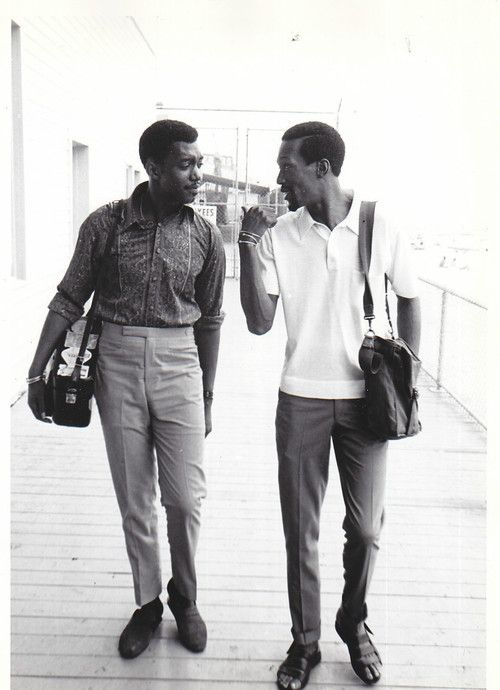
Otis Williams and Eddie Kendricks of The Temptations wear high rise, narrow leg trousers
Pant materials moved away from dressy wools into the new stretch knit synthetics that allowed more and smaller patterns to dominate men’s pants of the 60s. Plaids checks, herringbone, angled pinstripes, vertical stripes, and corduroy each called attention to a man’s lower half. A slight flare at the ankle was a precursor to the bells to come starting in 1968-69. They fit over the boots every mod was wearing. Some beach or summer pants cropped a few inches above the ankle featured the bell shape already, but the explosion of big bell-bottom pants was not part of the mod style.
- 1967 Wrangler jeans in mod colors
- 1968 turtleneck shirts and slim mod pants
- 1969 slim pattern pants or solid colors
- 1969 men mock neck shirts and pattern pants
In 1968, all things Flower Power were blending mod and psychedelic hippie styles together. For men, pants now featured large flower prints, tribal designs, paisley, and vertical stripes. Wide wale corduroy pants were also best sellers for the less bold. By 1969 the flared leg pant was replacing the skinny pant.
The blue jean, too, entered mainstream fashion circles. Jeans now featured a low rise waistband and flared legs with a snug fit. The straight leg jean was also popular, at first as workwear or a western denim pant and later as mod fashion.
Shop 60s men’s pants, jeans, trousers.
- 1969 plaids and stripes flared pants
- 1970 psychedelic “Flower power” pants
- 1960s Levi’s mod jeans
- 1969 Levis jeans style 606
Mod Men’s Coats and Jackets
Oddly enough, the mods turned back to the past with long crombie overcoats in big plaids or plain colors, velvet textures, Edwardian brocades, and shiny tanned leathers. Most overcoats hung straight down with small collar and little or no lapels. The fitted overcoat was the opposite of the minimalist mod style. It was more common in Britain than in America.
Americans and Brits loved the fishtail Army parka. Army green with a tie waist and hood, it was casual, warm, and an odd contrast to mod pants and shoes.
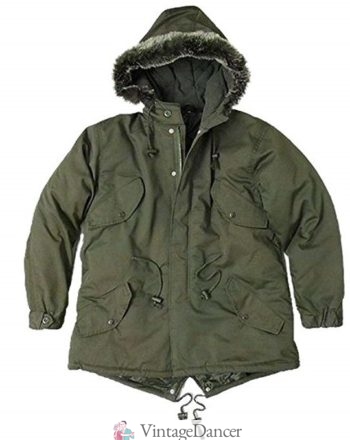
Fishtail Parka
In America, casual jackets with soft shirts and tight pants were preferred over the more formal topcoat. The Nehru jacket trended in 1967-1968. It had a long fitted tunic jacket with round, stand-up collar (Mao collar). They could be plain colors, but Americans preferred brightly colored and patterned Nehru jackets. Collars, cuffs, and edges were sometimes highly decorated and trimmed.
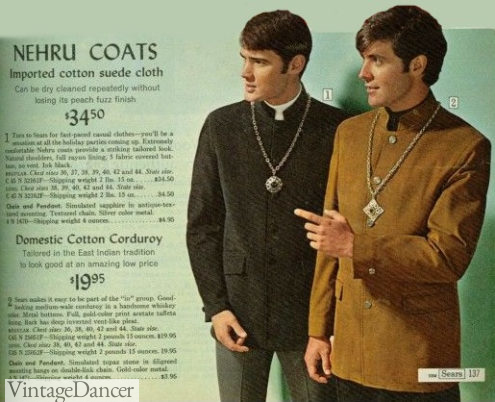
1968 Nehru jackets
There were other new collars and lapel shapings on designer mod suits in the 60s. The Cloverleaf and L-shaped lapels added subtle variation to classic suits. The Bal collar, mandarin collar, and collarless jacket each offered a striking new international look to the mod style. Once this style was made into service uniforms (bellhops, waiters, clerks) the look went out of fashion.
The double-breasted navy blue pea coat was the other style of winter coat that started with the mods, but was quickly adopted by mainstream America and Canada.
- 1966 melton wool navy pea coat with cap was a mod style signature
- 1966 pea coats for Mods in Canada too
- British mod jacket, shirt, vest
- 1969 zip jacket and neck scarf- the mod look of the early 70s
The colored leather trench coat with an all-around belt was for the boldest of the mods. Antique leather coats came in many other styles as well, usually of the shorter models, and in every color from black to red.
- 1969 men’s trench coats
- 1968 leather jackets in new colors that stood out
Finally, the Harrington jacket/bomber jacket/golf jacket was also adopted by Mods. It changed subtly over the decade into a light collarless windbreaker with elastic wristbands. They echoed the “cool” and stylish Italians who rode Vespas, the preferred transportation of Mod men.
- 1969 Harrington Jacket
- 1967 McGregor-Doniger mod mens windbreaker jackets
60s Mod Shoes
Boots, especially Chelsea boots and half ankle booties, were the big new shoe style for mod men in the 1960s. Young executives wore them with a suit during the day and with casual pants and shirts on the weekends. Lace up traditional boots worn by the Edwardians fit perfectly into the dressy mod wardrobe too.
Oxfords were generally out but still an option, while slip-on loafers, monk straps, and mocs with buckle straps (especially in very dark or very light colors) were high fashion in the Space Age. Shoes were simple, streamlined, and shiny. The winklepicker shoe with one to two eyelet lacing and sharp pointy toe was the extreme mod shoe. Very pointy toes were problematic, so the trend died quickly.
- 1964 modern shiny shoes
- 1964 pointed toe shiny black shoes
- 1966 boots, oxford and slip-ons
- 1966 young mod shoes “high, lean and handsome”
By the end of the decade, shoes came in bright colors as well as a revival of classic two-tone- black and white wingtips. Most shoes were worn with…. white socks!
Casual mod shoes embraced the suede Chukka boot, suede loafer, and bowling shoes. Tri-color bowling shoes were a unique mod shoe that intended to stand out rather than blend in. Bright bowling shoes with a plain dark suits certainly did the trick.
Cuban heel boots aka Beatle Boots, buckle strap boots, or Chelsea boots were just a few of the boot and bootie styles that the mods favored. They wore them with ankle cropped pants and vivid printed socks.
- 1969 buckle boots
- 1969 monk strap, wingtips and loafers
Mod Men’s Accessories
Hats: The mods wore the Dutch boy/trainman/fisherman/ Nureyev cap in cloth or leather. Just about any kind of short-brimmed cap was acceptable. History of 60s hats.
Neckties: Bow ties, traditional and skinny neckties, as well as ascots of silk tied in a fluffy puff or big bow were part of the mod fashion. Apache scarves with paisley or floral prints tied at the side of the neck or in front if worn with a Nehru jacket were the most dramatic. The late 60s saw the extra-wide tie in paisley or polka dots.
Sunglasses: Round glasses, square (really they are thin rectangles), and aviator sunglasses with plastic or metal frames.
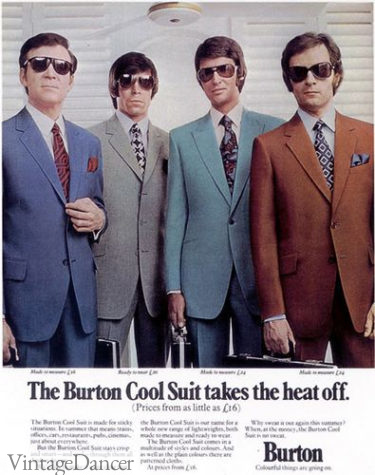
Sunglasses for Mods
Mod Men’s Outfits
For the classic mod look start with a pair of slim fit trousers in a bright solid color or distinct pattern such as plaids or checks. Add a thin or wide simple belt and top with a knit shirt- turtleneck, mock neck, polo or button down cotton check shirt. Add a Harrington jacket if you need a another layer or a sweater. Choose patent leather black shoes, loafers or Chelsea boots.
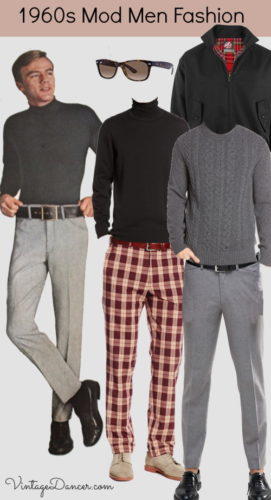
1960s mod mens outfits
Shop 60s men’s style clothing
Shirts | Jackets | Pants | Shoes
Debbie Sessions has been teaching fashion history and helping people dress for vintage themed events since 2009. She has turned a hobby into VintageDancer.com with hundreds of well researched articles and hand picked links to vintage inspired clothing online. She aims to make dressing accurately (or not) an affordable option for all. Oh, and she dances too.
